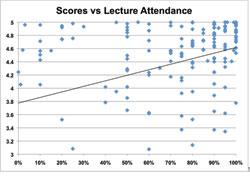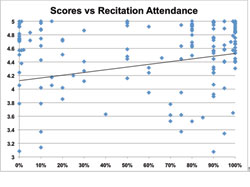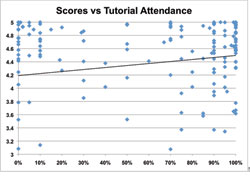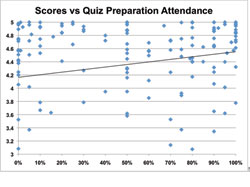
| Vol.
XXIII No.
2 November / December 2010 |
| contents |
| Printable Version |
Teach Talk
Looking at the Numbers
Each week, students in 6.034, Introduction to Artificial Intelligence, attend, or are supposed to attend, two lectures, a recitation section, a tutorial, and a quiz preparation session. Lectures introduce the big picture and editorialize; recitations provide opportunity for discussion; tutorials focus on the homework; and the quiz preparation sessions explain how to work past quiz problems.
We have argued, over the years, about how the four very different elements correlate with performance, and wondered which element, if any, we could drop. During the 2009 final, we asked students to estimate the percentage of the lectures, recitations, tutorials, and quiz sessions he or she attended. About 85% of about 200 students gave us their estimates.
It wasn't a scientific study, because the students were just guessing and perhaps did not trust our assertion that the estimates would have no effect on grades. Also, we have a highly nonstandard and nonlinear way of computing scores (see previous Faculty Newsletter article).
Nevertheless, points of interest emerged. For example, we noted that recitation and tutorial attendance were plainly bimodal, in line with our previous impressions. Curiously, quiz session attendance was less sharply bimodal and lectures not at all.
We were pleased to see there was a positive correlation between scores and the percentage of each type of element attended. We had braced ourselves against the possibility that the regression lines would be flat or nearly so.
Of course, we reminded ourselves not to confuse correlation with cause. A likely explanation for the positive slopes is that those who take the subject more seriously are more engaged in general, and that more engaged means spending more time studying as well as dragging oneself out of bed for a 10 am lecture.
On the other hand, we would not have been all that crushed if a more careful study produced gentler slopes. All that the lines measure is problem-solving skill demonstrated on examinations. We don't know how to measure, for example, whether a powerful idea gets conveyed or a passion develops. Feedback on that comes in only anecdotally, sometimes decades later.
| Back to top | |
| Send your comments |
| home this issue archives editorial board contact us faculty website |



